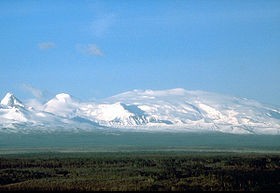Mount Wrangell
| Mount Wrangell | |
|---|---|

Mount Wrangell, 1987
|
|
| Highest point | |
| Elevation | 14,163 ft (4317 m) NAVD88 |
| Prominence | 5613 ft (1711 m) |
| Isolation | 14.79 mi (23.8 km) |
| Listing | |
| Coordinates | 62°00′21″N 144°01′10″W / 62.00572°N 144.01935°WCoordinates: 62°00′21″N 144°01′10″W / 62.00572°N 144.01935°W |
| Geography | |
| Location | Wrangell-St. Elias National Park and Preserve, Alaska, U.S. |
| Parent range | Wrangell Mountains |
| Topo map | USGS Gulkana A-1 |
| Geology | |
| Age of rock | |
| Mountain type | Shield volcano |
| Volcanic arc/belt | Wrangell Volcanic Field |
| Last eruption | August 2002 |
Mount Wrangell, in Ahtna K’ełt’aeni or K’ełedi when erupting, is a massive shield volcano located in Wrangell-St. Elias National Park and Preserve in southeastern Alaska, United States. The shield rises over 12,000 feet (3,700 m) above the Copper River to its southwest. Its volume is over 220 cubic miles (920 km3), making it more than twice as massive as Mount Shasta in California, the largest stratovolcano by volume in the Cascades. It is part of the Wrangell volcanic field, which extends for more than 250 km across Southcentral Alaska into the Yukon Territory, and has an eruptive history spanning the time from Pleistocene to Holocene.
Modern Mount Wrangell, built upon the remnants of a mid-Pleistocene volcano, has an eruptive history spanning from 750,000 years ago to minor phreatic eruptions in 1884. The shield volcano features an ice-filled caldera 2.5 by 3.7 miles (4 by 6 km) in diameter at the top of Wrangell's broad summit. The caldera was apparently formed by subsidence rather than large explosive eruptions. The caldera is in turn rimmed by three small craters, which often display fumarolic activity with steam plumes that can sometimes be seen from a distance. The main summit is on the north side of the caldera, while the west summit rises to 14,013 feet (4,271 m). The summit region above 13,000 feet (4,000 m) in elevation is over 2 by 5 miles (3 by 8 km) in size. A very large cinder cone, 13,009-foot (3,965 m) Mount Zanetti, rises nearly 1,000 feet (300 m) above the northwest flank of Wrangell and is the source of some lava flows.
Wrangell is unusual in that despite being a shield volcano, it is made mainly of andesite rather than basalt, which forms most shield volcanoes in other parts of the world. A few other volcanoes in the Wrangell Volcanic Field also share this feature. Andesite is a volcanic rock found mainly in stratovolcanoes and tends to form short, stubby flows. How Wrangell grew into a shield volcano is poorly understood, but its lava flows appear to have been voluminous and were also probably generated by high eruption rates.
...
Wikipedia

